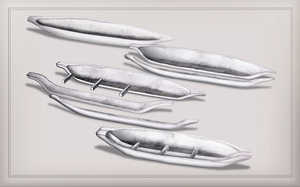Dugouts
Writing about the inhabitants of the coast of the Bay of
Biscay, Strabo says that “up to the time of Brutus' expedition
[138-137 BCE] they used boats of tanned leather on account of the flood-tides and the shoal-waters, but now, already,
even the dug-out canoes are rare”.
This type of craft, known as logboats, dugouts or monoxylons
and made of a single piece of wood, have been used in
nearly all areas of Europe where trees of a sufficient diameter
are available.
Once the inside has been dug out, they can hold one or
more people.
The Basque Country was no exception and this modest craft
lasted longer than any other along these coasts, and was still
in use until the nineteenth century; iconography and
archaeology shows that this type of vessel was widely used
on the River Aturri.

The operation consists of hollowing out the trunk of an oak
tree, smoothing it out with an axe and then hollowing it out with
adzes. In some cases the structure was reinforced by fashioning
buttresses, like ribs, which gave the structure greater strength, and
also helped shape it. This type of vessel was not very stable and
could only be used in rivers and estuaries. They were propelled
along using a pole or sculls. © José Lopez

Oar used in the replica canoe. © José Lopez

Iron axe. Nineteenth Century. © José Lopez

Oak tree. Quercus robur. © José Lopez

Neolitiko ontzi monoxilo primitiboak konifera enborrak erabiliz egiten zituzten eskuarki, zur bigun hori erraz landu zezaketen eta harrizko lanabesak erabilita. Geroago, lanabesetan metalak, burdina batez ere, sartzen hasi zirelarik, haritz enborrak mozteko eta lantzeko aukera izan zuten. Hauen zur gogorrak eta lantzeko aukera izan zuten. Hauen zur gogorrak askoz gehiago irauten du ur ingurunean. © José Lopez

Replica of the canoe in the Basque Museum in Bayonne
ma-de by the Albaola association. It was made using only hand
tools and required approximately 360 hours work. After launched
it was tested on the water, and was found to be suitable for a crew
of three. © José Lopez

Dugout found on the banks of the River Aturri in the Basque
Museum in Bayonne. It has been dated to the eighteenth century,
and is evidence of a technology that remained in use for over two
thousand years. © José Lopez

Primitive stone-age dugouts were generally made from conifer
trees, because the soft wood was more easily worked with stone
tools. The introduction of metal, particularly iron, for making tools led
to the felling and fashioning of oak trunks, whose hard wood is much
more water-resistant. © José Lopez

Early stone-age axe. © José Lopez

Diagram showing how the dugout canoe was transformed into
a larger vessel. © José Lopez

Transport craft depicted in the Jouve album (1679), used around
the end of the seventeenth century to travel up the Aturri and its
tributaries, linking Bayonne and the coast with the hinterland. This
is a vessel with dugout sides joined by intermediate pieces to give
it a wider beam, thus overcoming the limits placed by the diameter
of the tree. © José Lopez

Scotch pine. Pinus silvestris. © José Lopez
















